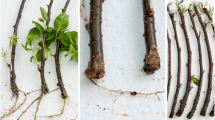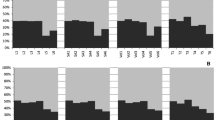Abstract
In-field variation of transplanted lettuce (Lactuca sativa L.) due to variable soil and environmental conditions is one of the major restrictions in the optimization of production and yield. Marker-assisted breeding for lettuce varieties with a more rapid rooting phenotype has the potential to improve the performance of lettuce transplants. This study aimed to identify traits linked with increased primary root length, lateral root length and lateral root emergence in 14-day L. sativa seedlings from an intra-specific cross (Saladin × Iceberg). In total, 16 significant quantitative trait loci (QTLs) were associated with increased root growth traits that would allow direct introgression of the traits. Six of the QTLs were associated with increased primary root growth, accounting for 60.2% of the genetic variation for the trait. Three QTLs were associated with lateral root growth (38.6% of genetic variation); two QTLs were associated with lateral root length density (27.6% of genetic variation) and three with root number density (33.4% of genetic variation), and two QTLs were associated with mean lateral root length (21.1% of genetic variation). The statistical QTLs were located across 9 different linkage groups (LGs) representing loci on 7 of the 9 L. sativa chromosomes. A combination of restriction fragment length polymorphism (RFLPs) and Kompetitive allele specific PCR (KASPs) markers linked to these rooting traits were identified, which could allow breeders to select for a rapid establishment phenotype.



Similar content being viewed by others
References
Abràmoff MD, Magalhães PJ, Ram SJ (2004) Image processing with ImageJ. Biophotonics Intern 11(7):36–42
Atkinson LD, LK MH, Truco MJ, Hilton HW, Lynn J, schut JW, Michelmore RW, Hand P, DAC P (2013) An intra-specific linkage map of lettuce (Lactuca sativa) and genetic analysis of postharvest discolouration traits. Theor Appl Genet 126(11):2737–2752
Atkinson JA, Wingen LU, Griffiths M, Pound MP, Gaju O, Foulkes MJ, Le Gouis J, Griffiths S, Bennett MJ, King J, Wells DM (2015) Phenotyping pipeline reveals major seedling root growth QTL in hexaploid wheat. J Exp Bot 66:2283–2292
Biddington NL, Dearman AS (1984) Shoot and root growth of lettuce seedlings following root pruning. Ann Bot 53:663–668
Fitter AH, Stickland TR (1991) Architectural analysis of plant root systems 2. Influence of nutrient supply on architecture in contrasting plant species. New Phytol 118:383–389
Fitter AH, Stickland TR, Harvey ML, Wilson GW (1991) Architectural analysis of plant root systems 1. Architectural correlates of exploitation efficiency. New Phytol 118:375–382
Grassbaugh EM, Bennett MA (1998) Factors affecting vegetable stand establishment. Scientia Agricola 55:116–120
Jackson (1995) Root architecture in cultivated and wild lettuce (Lactuca spp.). Plant Cell Environ 18(8):885–894
Jansen RC, Stam P (1994) High resolution of quantitative traits into multiple loci via interval mapping. Genetics 136:1447–1455
Johnson WC, Jackson LE, Ochoa O, van Wijk R, Peleman J, St. Clair DA, Michelmore RW (2000) Lettuce, a shallow-rooted crop, and Lactuca serriola, its wild progenitor, differ at QTL determining root architecture and deep soil water exploitation. Theor Appl Genet 101:1066–1073
Kerbiriou PJ, Stomph TJ, Lammerts van Bueren ET, Struik PC (2013) Influence of transplant size on the above- and below-ground performance of four contrasting field-grown lettuce cultivars. Front Plant Sci 4(379):1–16
Le Marié C, Kirchgessner N, Marschall D, Walter A, Hund A (2014) Rhizoslides: paper-based growth system for non-destructive, high throughput phenotyping of root development by means of image analysis. Plant Methods 10(13):1–16
Maltais A, Gosselin A, Tremblay N, Winden V (2008) Effects of temperature and fertigation on lettuce seedling production using peat blocks. Acta Hortic 782:367–374
Mooney SJ, Pridmore TP, Helliwell J, Bennett MJ (2012) Developing X-ray computed tomography to non-invasivley image 3-D root systems architechture in soil. Plant Soil 352:1–22
NeSmith DS, Duval JR (1998) The effect of container size. HortTechnology 8(4):495–498
Orzolek MD (1991) Establishment of vegetables in the field. HortTechnology 1(1):78–81
Schneider CA, Rasband WS, Eliceiri KW (2012) NIH image to ImageJ: 25 years of image analysis. Nat Methods 9(7):676–682
Sharma N, Abrams SR, Waterer DR (2005) Abscisic acid analogs reduce transplant shock in tomato seedlings. J Veg Sci 11(3):41–56
Steele KA, Price AH, Shashidhar HE, Witcombe JR (2006) Marker-assisted selection to introgress rice QTLs controlling root traits into an Indian upland rice variety. Theor Appl Genet 112:208–221
Steele KA, PriceAH WJR, Shrestha R, Singh BN, Gibbons JM, Virk DS (2013) QTLs associated with root traits increase yield in upland rice when transferred through marker-assisted selection. Theor Appl Genet 126(1):101–108
Thomas CL, Graham NS, Hayden R, Meacham MC, Neugebaur K, Nightingale M, Dupuy LX, Hammond JP, White PJ, Broadley MR (2016) High-throughput phenotyping(HTP) identifies seedling root traits linked to variation in seed yield and nutrient capture in field-grown oilseed rape (Brassica napus L.). Ann Bot 118:655–665
Van Iersel M (1998) Auxins affect posttransplant shoot and root growth of vinca seedlings. HortScience 33(7):1210–1214
Van Ooijen JW (1999) LOD significance thresholds for QTL analysis in experimental populations of diploid species. Heredity 83:613–624
Wei Z, Julkowska MM, Laloë J-O, Hartman Y, de Boer G-J, Michelmore RW, van Tienderen PH, Testerink C, Schranz ME (2014) A mixed-model QTL analysis for salt tolerance in seedlings of crop-wild hybrids of lettuce. Mol Breed 34(3):1389–1400
Xie Q, Fernando KMC, Mayes S, Sparkes DL (2017) Identifying seedling root architectural traits associated with yield and yield components in wheat. Ann Bot-London 119(7):1115–1129
Zeng Z-B (1994) Precision mapping of quantitative trait loci. Genetics 136:1457–1468
Zhu J, Ingram PA, Benfey PN, Elich T (2011) From lab to field, new approaches to phenotyping root system architecture. Curr Opin Plant Biol 14:310–317
Acknowledgements
The research undertaken in this study was conducted primarily at Harper Adams University. A special thank you goes to Catherine Thomas who helped with the initial modification of the high-throughput platform for the use with lettuce seedlings, Rory Hayden for delivery of the equipment to Harper Adams University and Lolita Wilson for all her support at The University of Nottingham. Gratitude also goes to Shelley Roberts for her help with placement of the seedlings within the platform.
Funding
We would like to thank our collaborative funding bodies; Syngenta, Harper Adams University and the University of Nottingham and the Vegetable Genetic Improvement Network for providing the plant materials to use in this study.
Author information
Authors and Affiliations
Contributions
JR: Carried out the main body of the research and main author of the paper.
JM: Principle research and paper advisory.
MRB: Secondary research and paper advisory.
DP: Secondary research and paper advisory.
PH: Principle advisory for QTL analysis and secondary paper advisory.
JL: Principle advisory for the statistical analysis of trait data.
Corresponding author
Ethics declarations
Conflict of interest
The authors declare that they have no conflict of interest.
Additional information
Publisher’s note
Springer Nature remains neutral with regard to jurisdictional claims in published maps and institutional affiliations.
Key message
The study has identified genotypic variation for root growth traits within cultivated lettuce that will allow direct introgression of these traits into commercial cultivars for improved uniformity and establishment.
Rights and permissions
About this article
Cite this article
Roberts, J., Broadley, M.R., Pink, D. et al. Quantitative trait loci (QTLs) linked with root growth in lettuce (Lactuca sativa) seedlings. Mol Breeding 40, 8 (2020). https://doi.org/10.1007/s11032-019-1089-x
Received:
Accepted:
Published:
DOI: https://doi.org/10.1007/s11032-019-1089-x




